Using Soil Sustainability and Resilience Concepts to Support Future Land Management Practice: A Case Study of Mt Grand Station, Hāwea, New Zealand
Abstract
:1. Introduction
2. Materials and Methods
2.1. Location and Geology
2.2. Soils
2.3. Soil Attributes to Use to Define Soil Resilience and Soil Sustainability
3. Results
Defining the Soil Resilience Variables and Their Spatial Extent at Mt Grand Station
4. Discussion
4.1. Bioindicators for Soil Quality
4.2. Allocated Class and Association with Soil Type
5. Conclusions
Author Contributions
Funding
Data Availability Statement
Acknowledgments
Conflicts of Interest
References
- Rounsevell, M.; Evans, S.; Bullock, P. Climate Change and Agricultural Soils: Impacts and Adaptation. Clim. Chang. 1999, 43, 683–709. [Google Scholar] [CrossRef]
- Varallyay, G. The impact of climate change on soils and on their water management. Agron. Res. 2010, 8, 385–396. [Google Scholar]
- Borrelli, P.; Robinson, D.A.; Panagos, P.; Lugato, E.; Yang, J.E.; Alewell, C.; Wuepper, D.; Montanarella, L.; Ballabio, C. Land use and climate change impacts on global soil erosion by water. Proc. Natl. Acad. Sci. USA 2020, 117, 21994–22001. [Google Scholar] [CrossRef] [PubMed]
- Hamidov, A.; Helming, K.; Bellocchi, G.; Bojar, W.; Dalgaard, T.; Ghaley, B.B.; Hoffmann, C.; Holman, I.; Holzkämper, A.; Krzeminska, D.; et al. Impacts of climate change adaptation options on soil functions: A review of European case-studies. Land Degrad. Dev. 2018, 29, 2378–2389. [Google Scholar] [CrossRef] [PubMed]
- IPCC. Special Report on Climate Change, Desertification, Land Degradation, Sustainable Land Management, Food Security, and Greenhouse Gas Fluxes in Terrestrial Ecosystems (SRCCL); IPCC (Report); IPCC: Geneva, Switzerland, 2019; Available online: https://www.ipcc.ch/srccl/ (accessed on 8 August 2021).
- Karlen, D.L.; Mausbach, M.J.; Doran, J.W.; Cline, R.G.; Harris, R.F.; GE Schuman, G.E. Quality: A Concept, Definition, and Framework for Evaluation. Soil Sci. Soc. Am. J. 1997, 61, 4–10. [Google Scholar] [CrossRef] [Green Version]
- Ludwig, M.; Wilmes, P.; Schrader, S. Measuring soil sustainability via soil resilience. Sci. Total Environ. 2018, 626, 1484–1493. [Google Scholar] [CrossRef]
- Forman, R.T.T.; Godron, M. Landscape Ecology; John Wiley and Sons Ltd.: New York, NY, USA, 1986; p. 620. [Google Scholar]
- Bezdicek, D.F.; Papendick, R.I.; Lal, R. Introduction: Importance of Soil Quality to Health and Sustainable Land Management. In Methods for Assessing Soil Quality; Doran, J.W.J.W., Jones, A.J., Eds.; Soil Science Society of America: Madioson, WI, USA, 1997; pp. 1–8. [Google Scholar]
- Herrick, J.; Wander, M. Relationships Between Soil Organic Carbon and Soil Quality in Cropped and Rangeland Soils: The Importance of Distribution, Composition and Soil Biological Activity. In Soil Processes and the Carbon Cycle; Lal, R., Kimble, J.M., Follett, R.F., Stewart, A.A., Eds.; CRC Press: Boca Raton, FL, USA, 1998; pp. 405–426. [Google Scholar]
- Williams, J.C.J. Chartres Sustaining productive pastures in the tropics: 1. managing the soil resource. Trop. Grassl. 1991, 25, 73–84. [Google Scholar]
- Seybold, C.A.; Herrick, J.E.; Brejda, J. Soil resilience: A fundamental component of soil quality. Soil Sci. 1999, 164, 224–234. [Google Scholar] [CrossRef]
- Doran, J.W.; Coleman, D.C.; Bezdicek, D.F.; Stewart, B.A. Defining Soil Quality for a Sustainable Environment; SSSA: Madison, WI, USA, 1994; p. 235. [Google Scholar]
- Jenny, H. The soil resource. Geochim. Et Cosmochim. Acta 1981, 45, 2519. [Google Scholar]
- Pierce, F.J.W.E.; Larson, W.E. Developing Criteria to Evaluate Sustainable Land Management. In Proceedings of the Eighth International Soil Management Workshop: Utilization of Soil Survey Information for Sustainable Land Use; Kimble, J.M., Ed.; USDA Soil Conservation Service, National Soil Survey Center: Lincoln, NE, USA, 1993; pp. 7–14. [Google Scholar]
- Orwin, K.H.; Wardle, D.A. New indices for quantifying the resistance and resilience of soil biota to exogenous disturbances. Soil Biol. Biochem. 2004, 36, 1907–1912. [Google Scholar] [CrossRef]
- Lehman, R.M.; Cambardella, C.A.; Stott, D.E.; Acosta-Martinez, V.; Manter, D.K.; Buyer, J.S.; Maul, J.E.; Smith, J.L.; Collins, H.P.; Halvorson, J.J.; et al. Understanding and Enhancing Soil Biological Health: The Solution for Reversing Soil Degradation. Sustainability 2015, 7, 988–1027. [Google Scholar] [CrossRef] [Green Version]
- De Vries, F.T.; Manning, P.; Tallowin, J.R.B.; Mortimer, S.R.; Pilgrim, E.S.; Harrison, K.A.; Hobbs, P.J.; Quirk, H.; Shipley, B.; Cornelissen, J.H.C.; et al. Abiotic drivers and plant traits explain landscape-scale patterns in soil microbial communities. Ecol. Lett. 2012, 15, 1230–1239. [Google Scholar] [CrossRef]
- Brevik, E.C.; Steffan, J.J.; Rodrigo-Comino, J.; Neubert, D.; Burgess, L.C.; Cerdà, A. Connecting the public with soil to improve human health. Eur. J. Soil Sci. 2018, 70, 898–910. [Google Scholar] [CrossRef]
- Bünemann, E.K.; Bongiorno, G.; Zhanguo, B.; Creamer, R.E.; De Deyn, G.; De Goede, R.; Fleskens, L.; Geissen, V.; Kuyper, T.W.; Mäder, P.; et al. Soil quality–A critical review. Soil Biol. Biochem. 2018, 120, 105–125. [Google Scholar] [CrossRef]
- Kibblewhite, M.G.; Ritz, K.; Swift, M.J. Soil health in agricultural systems. Philos. Trans. R. Soc. London. Ser. B Biol. Sci. 2008, 363, 685–701. [Google Scholar] [CrossRef] [Green Version]
- Baveye, P.C.; Baveye, J.; Gowdy, J. Soil “Ecosystem” Services and Natural Capital: Critical Appraisal of Research on Uncertain Ground. Front. Environ. Sci. 2016, 4, 1–41. [Google Scholar] [CrossRef]
- Booth, K.; McLean, J.; van Aswegan, S. Protecting the Natural and Cultural Landscapes of the Mackenzie Basin: A New Approach. Available online: https://vimeo.com/355293339 (accessed on 1 December 2021).
- Harmsworth, G. Oneone Ora, Tangata Ora: Soils and Māori Health and Wellbeing. In Te Mahi Oneone Hua Parakore: A Māori Soil Sovereignty and Wellbeing Handbook; Hutchings, J., Smith, J., Eds.; Harvest Fresh Scholarship from the Field: Christchurch, New Zealand, 2020; pp. 28–43. [Google Scholar]
- Sparling, G.P.; Lilburne, L.M.; Vojvodić-Vuković, M. Provisional Targets for Soil Quality Indicators in New Zealand; Landcare Research Science series, no. 34; Manaaki Whenua Press: Palmerston North, New Zealand, 2008; p. 64. [Google Scholar]
- Schwilch, G.; Bernet, L.; Fleskens, L.; Giannakis, E.; Leventon, J.; Marañón, T.; Mills, J.; Hort, C.S.; Stolte, J.; van Delden, H.; et al. Operationalizing ecosystem services for the mitigation of soil threats: A proposed framework. Ecol. Indic. 2016, 67, 586–597. [Google Scholar] [CrossRef]
- Lynn, I.H.; Manderson, A.K.; Page, M.J.; Harmsworth, G.R.; Douglas, G.B.; Mackay, A.D.; Newsome, P.J.F. Land Use Capability Survey Handbook—A New Zealand Handbook for the Classification of Land, 3rd ed.; Hamilton, AgResearch, Lincoln, Landcare Research; GNS Science: Lower Hutt, New Zealand, 2009; p. 163. [Google Scholar]
- Askari, M.S.; Holden, N.M. Quantitative Soil Quality Indexing of Temperate Arable Management. Soil Tillage Res. 2015, 150, 57–67. [Google Scholar] [CrossRef]
- Juhos, J.; Czigány, S.; Madarász, B.; Ladányi, M.M. Interpretation of soil quality indicators for land suitability assessment–A multivariate approach for Central European arable soils. Ecol. Indic. 2019, 99, 261–272. [Google Scholar] [CrossRef]
- Landis, C.A.; Campbell, H.J.; Begg, J.G.; Mildenhall, D.C.; Paterson, A.M.; Trewick, S.A. The Waipounamu Erosion Surface: Questioning the antiquity of the New Zealand land surface and terrestrial fauna and flora. Geol. Mag. 2008, 145, 173–197. [Google Scholar] [CrossRef] [Green Version]
- Turnbull, I.M. Geology of the Wakatipu Area: Scale 1:250,000; Institute of Geological & Nuclear Sciences: Lower Hutt, New Zealand, 2000. [Google Scholar]
- Leamy, M.L.; Saunders, W.M.H. Soils and Land Use in the Upper Clutha. Valley, Otago; NZ Soil Bureau Bulletin 28; NZDSIR: Taita, New Zealand, 1967; p. 107. Available online: http://digitallibrary.landcareresearch.co.nz/digital/collection/p20022coll7/id/74 (accessed on 9 August 2021).
- N.Z. Soil Bureau. Soils of New Zealand. Part 1; N.Z. Soil Bureau Bulletin, 26(1); NZDSIR: Taita, Lower Hutt, New Zealand, 1968; p. 142. [Google Scholar]
- Hewitt, A.E. New Zealand Soil Classification, 2nd ed.; Manaaki Whenua Press: Lincoln, New Zealand, 1998; p. 69. [Google Scholar]
- Webb, T.H.; Wilson, A.D. A Manual of Land Characteristics for Evaluation of Rural Land; Landcare Research science series, no. 10; Manaaki Whenua Press: Lincoln, Canterbury, New Zealand, 1996; p. 32. [Google Scholar]
- Lilburne, L.; Eger, A.; Mudge, P.; Ausseil, A.-G.; Stevenson, B.; Herzig, A.; Beare, M. The Land Resource Circle: Supporting land-use decision making with an ecosystem-service-based framework of soil functions. Geoderma 2020, 363, 114134. [Google Scholar] [CrossRef]
- Blakemore, L.C.; Searle, P.L.; Daly, B.K.B.K. Methods for Chemical Analysis of Soils; New Zealand Soil Bureau: Lower Hutt, New Zealand, 1987; p. 103. [Google Scholar]
- Lal, R.; Delgado, J.A.; Groffman, P.M.; Millar, N.; Dell, C.; Rotz, A. Management to mitigate and adapt to climate change. J. Soil Water Conserv. 2011, 66, 276–285. [Google Scholar] [CrossRef] [Green Version]
- Coyle, C.; Creamer, R.E.; Schulte, R.P.O.; O’Sullivan, L.; Jordan, P.P. A functional land management conceptual framework under soil drainage and land use scenarios. Environ. Sci. Policy 2016, 56, 39–48. [Google Scholar] [CrossRef] [Green Version]
- Hewitt, A.E.; Lowe, D.J.; Balks, M.R. The soils of Aotearoa New Zealand; Springer Nature: Cham, Switzerland, 2021; p. 352. [Google Scholar]
- Sojka, R.E.; Upchurch, D.R. Reservations regarding the soil quality concept. Soil Sci. Soc. Am. J. 1999, 63, 1039–1054. [Google Scholar] [CrossRef] [Green Version]
- Clearwater, R.L.; Martin, T.; Hoppe, T.T. Environmental Sustainability of Canadian Agriculture: Agri-environmental Indicator Report Series–Report #4; Agriculture and Agri-Food Canada: Ottawa, ON, Canada, 2016; p. 245. [Google Scholar]
- Velásquez, E.; Lavelle, P.; Andrade, M. GISQ, a multifunctional indicator of soil quality. Soil Biol. Biochem. 2007, 39, 3066–3080. [Google Scholar] [CrossRef]
- da Silva, L.C.M.; Avanzi, J.C.; Peixoto, D.S.; Merlo, M.N.; Borghi, E.; de Resende, A.V.; Salvador Francisco, S.F.; Silva, B.M. Ecological intensification of cropping systems enhances soil functions, mitigates soil erosion, and promotes crop resilience to dry spells in the Brazilian Cerrado. Int. Soil Water Conserv. Res. 2021, 9, 591–604. [Google Scholar] [CrossRef]
- Nouri, A.; Yoder, D.C.; Raji, M.; Caylan, S.; Jagadamma, S.; Lee, J.; Walker, F.R.; Yin, X.; Fitzpatrick, J.; Trexler, B.; et al. Conservation agriculture increases the soil resilience and cotton yield stability in climate extremes of the southeast US. Commun. Earth Environ. 2021, 2, 155. [Google Scholar] [CrossRef]
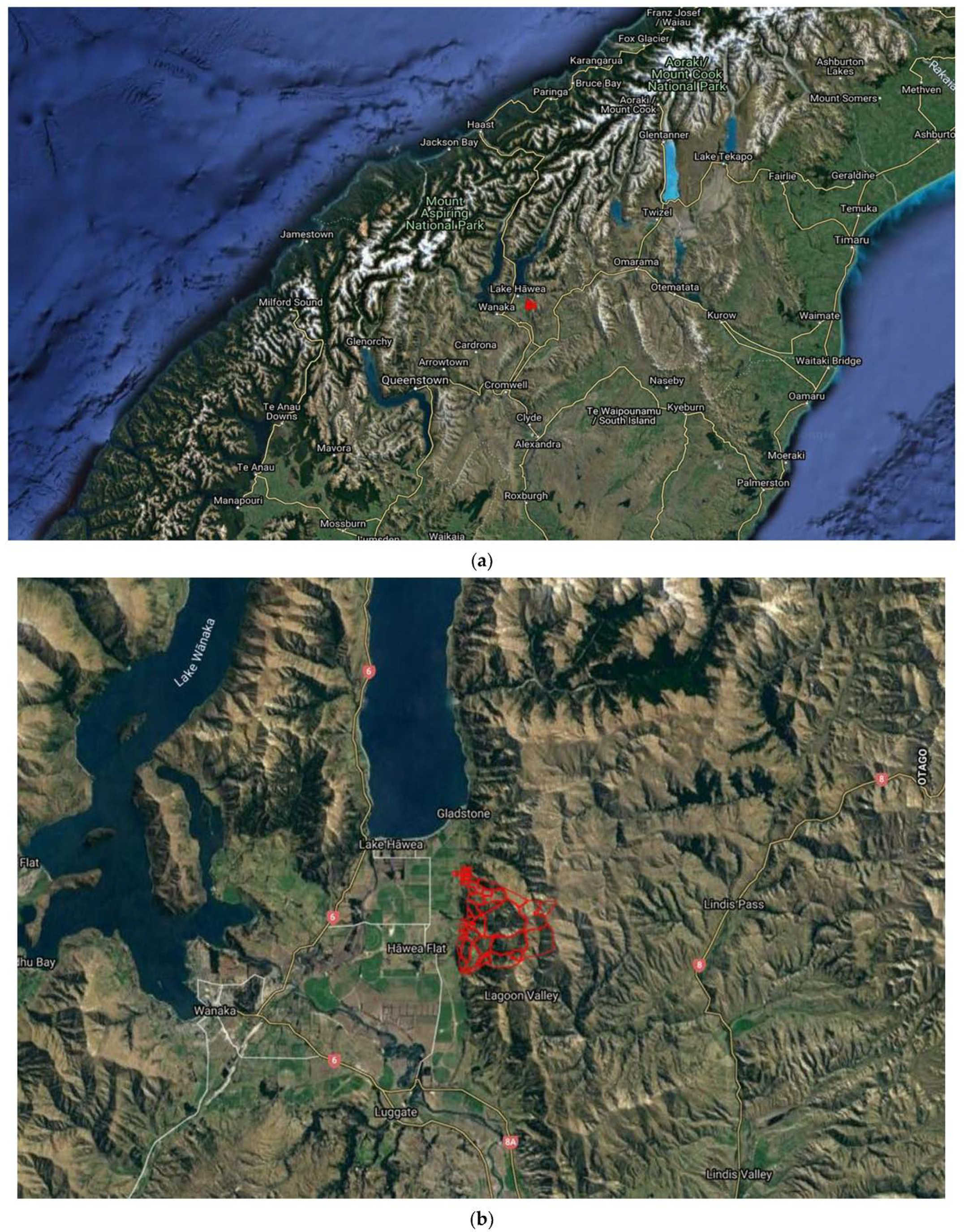
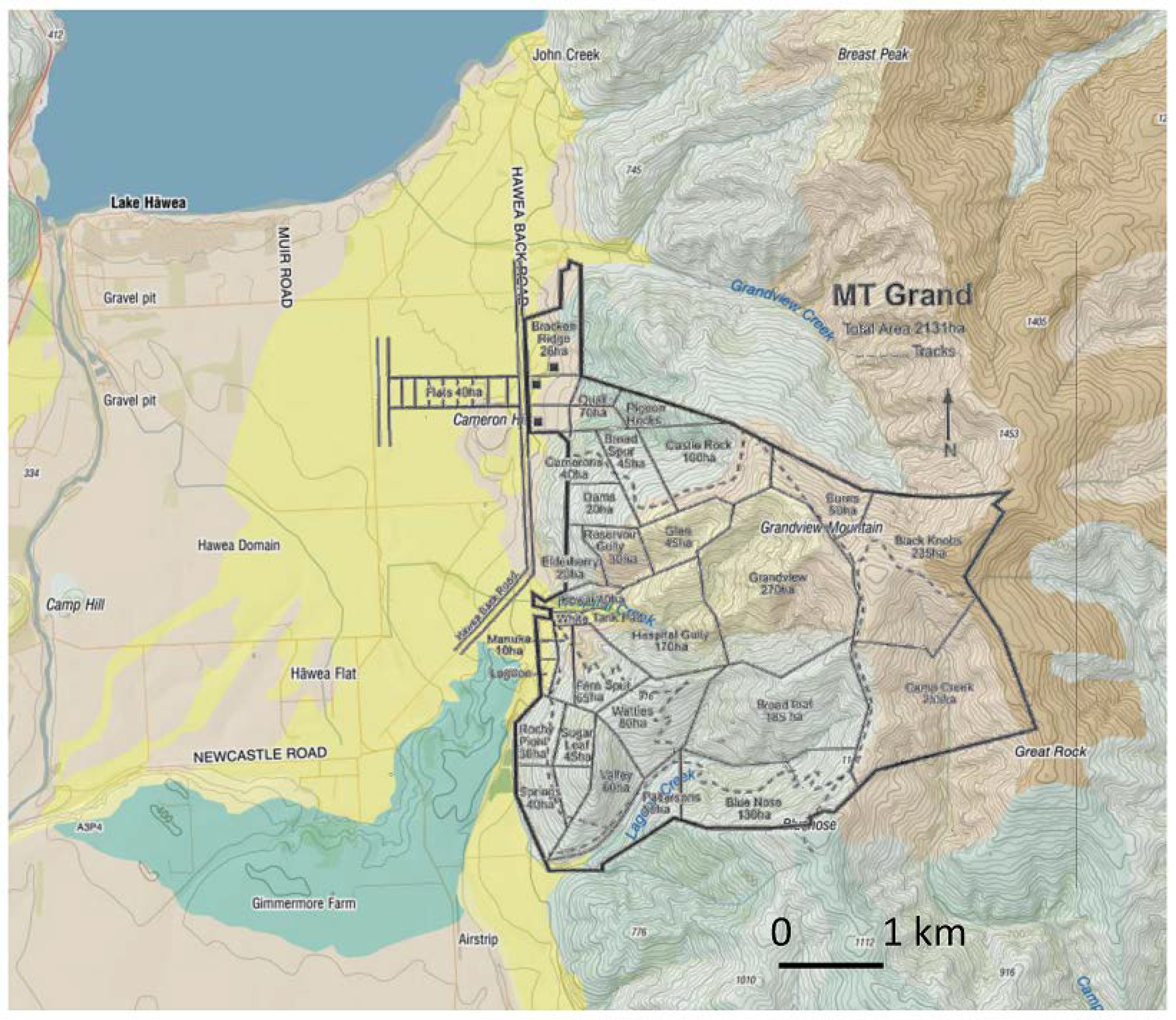
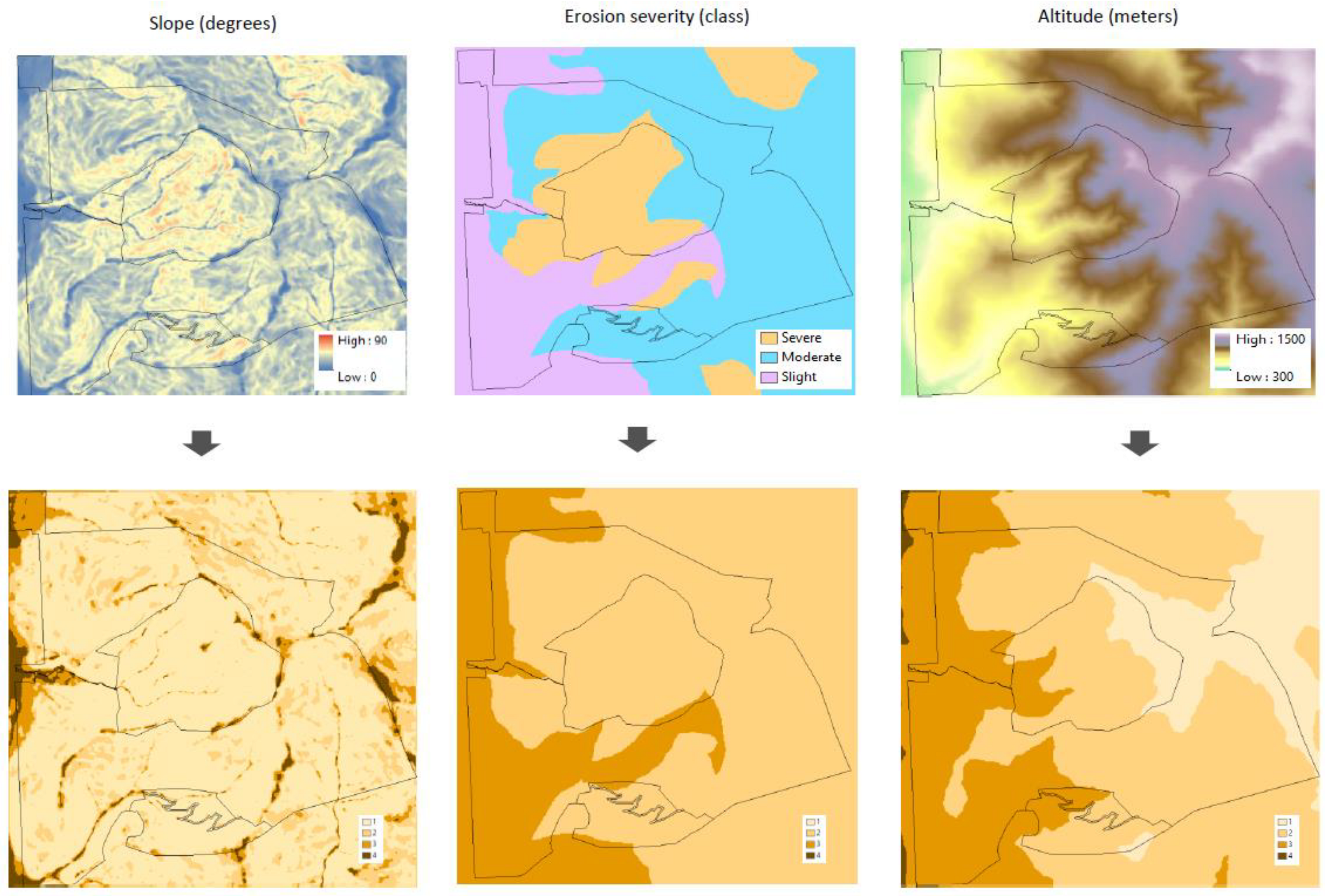
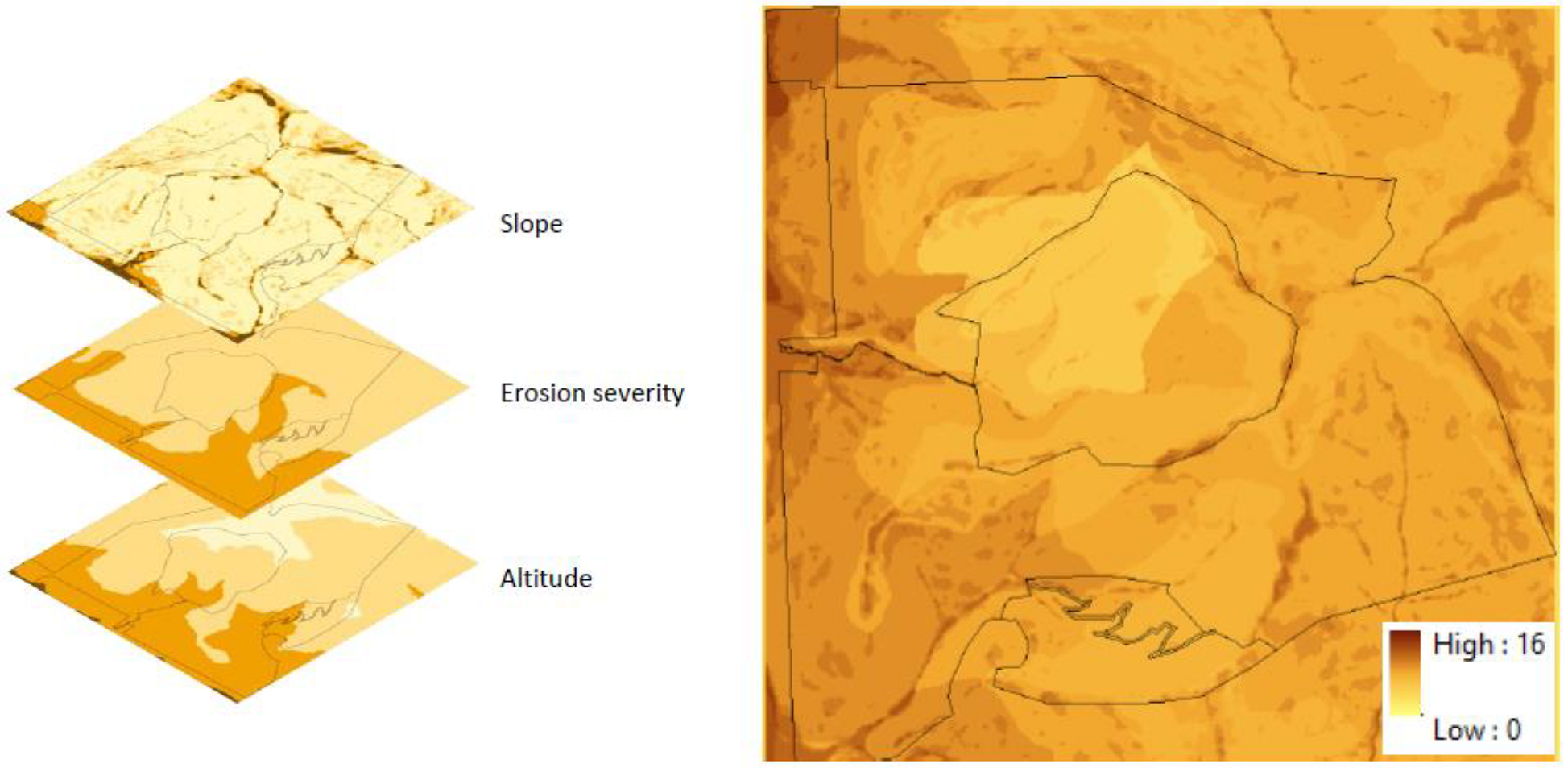
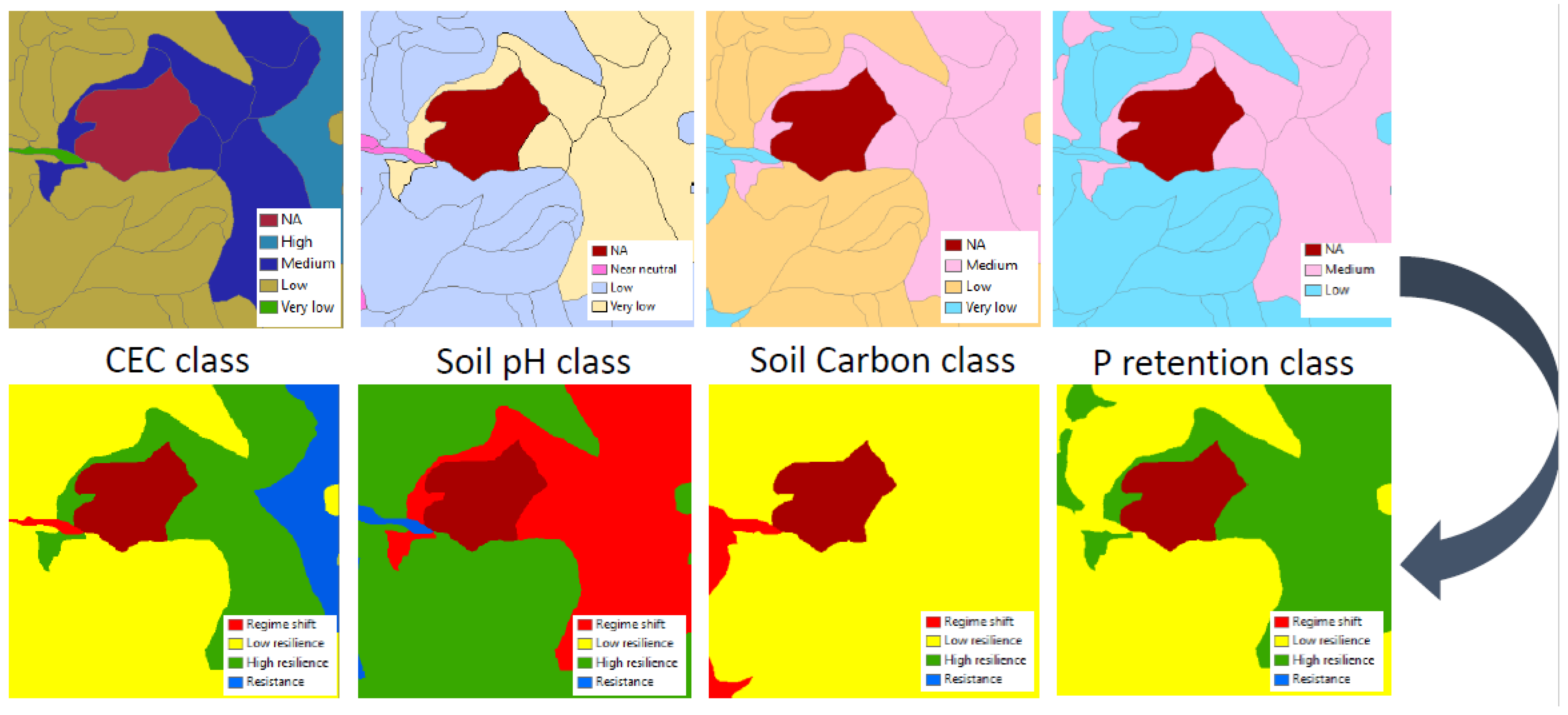
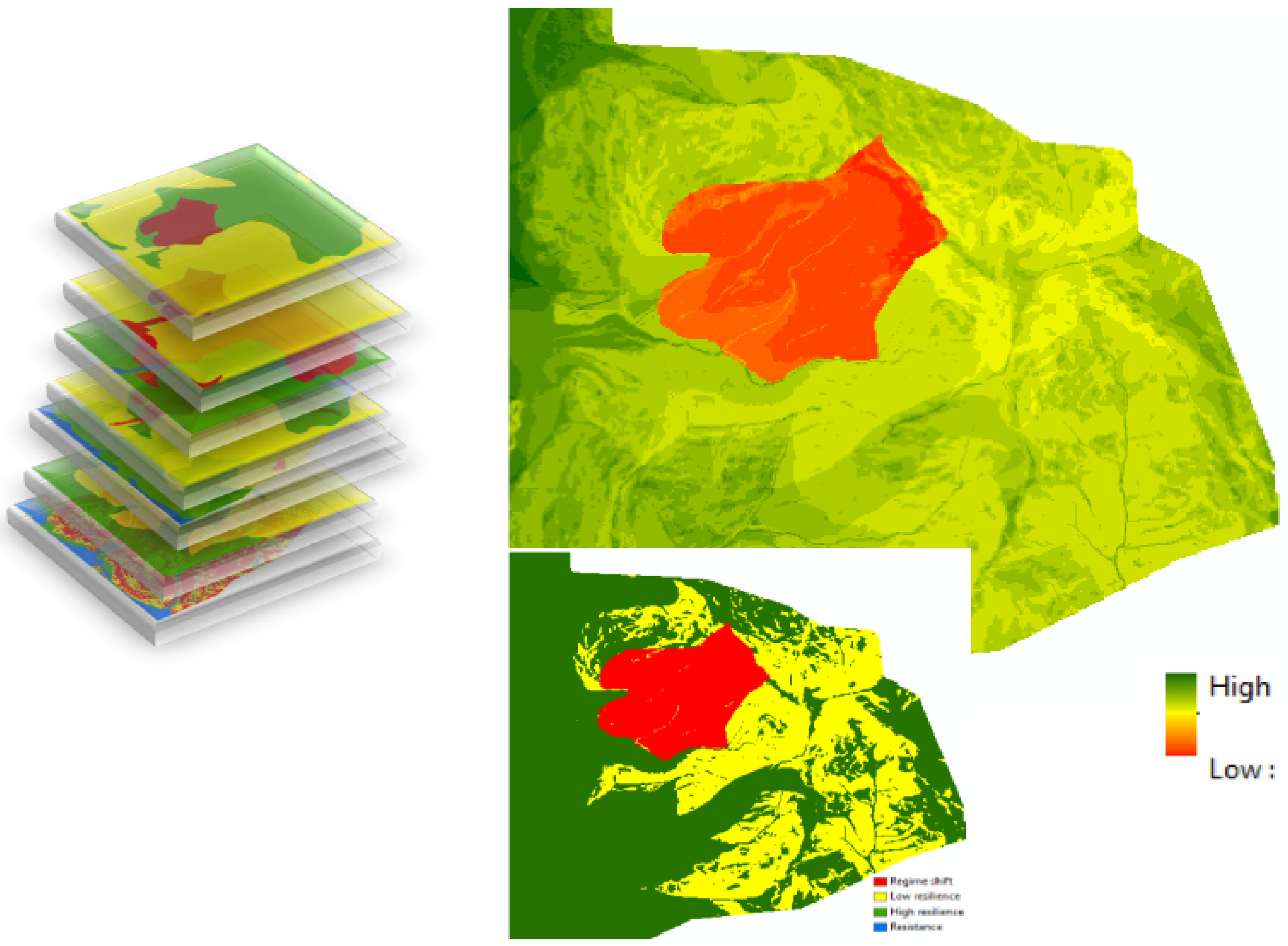
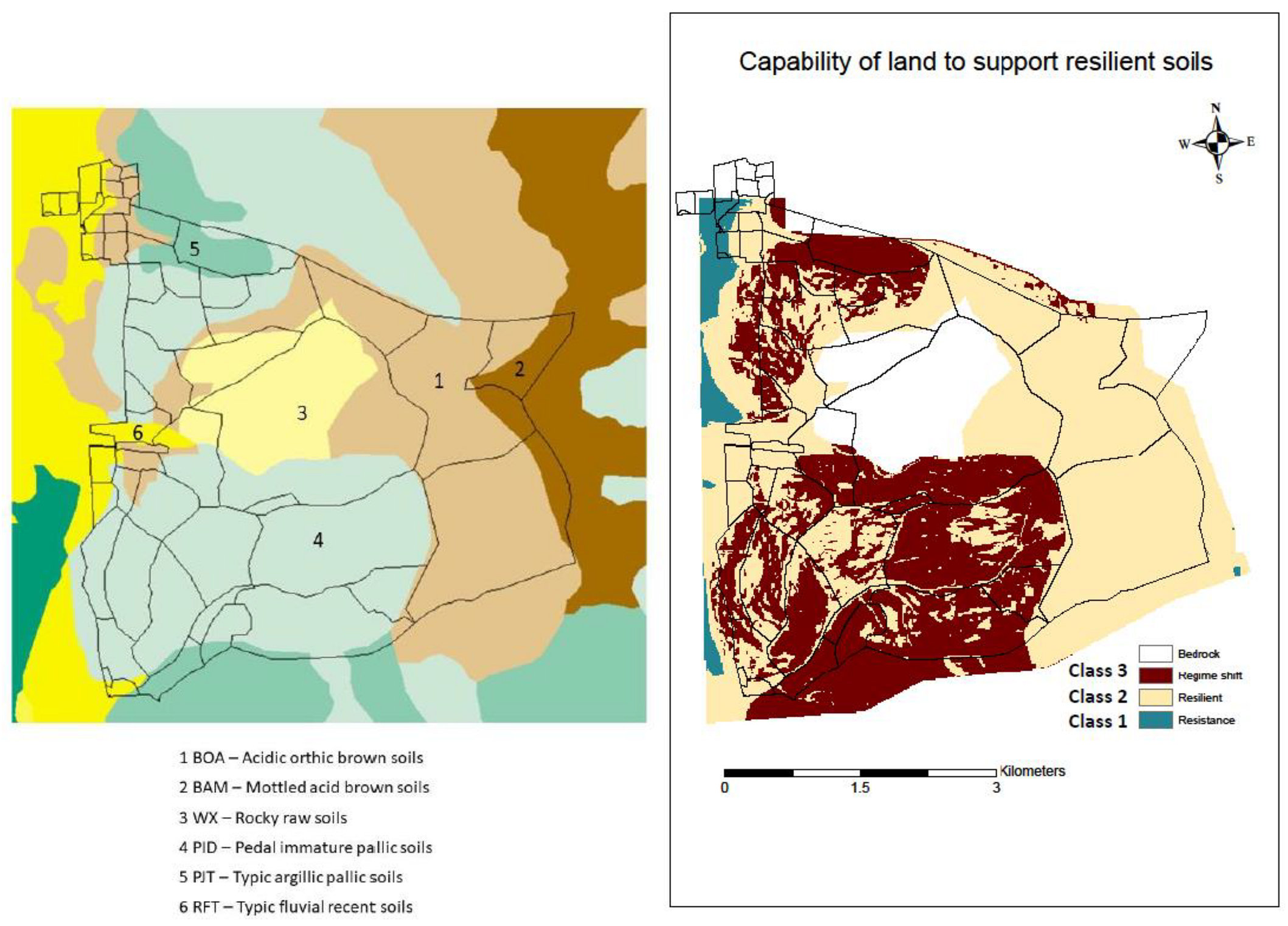
| Resilience Class | Disturbance Level | Ecosystem Response | Consequences | Change in Soil State |
|---|---|---|---|---|
| High | 1 | resistance | No consequences | No change |
| Medium | 2 | resilience | Structural change, eventual species composition change. No functional change | Temporary change—reversible |
| Low | 3 | Regime shift | Crossing the threshold. Structural and functional collapse. | Permanent change—irreversible. |
| Soil Series | Soil Unit (NSD) | NZSC (Order, Group, Subgroup) | Topography | Comment |
|---|---|---|---|---|
| Soils of the upland and hill country | ||||
| Dunstan 1 | 57d | acid orthic Brown | Steep-mod steep; some very steep. Schist and slope deposits with some locally sourced loess | Weakly weathered; but strongly leached at high rainfall& altitude. Erosion prone (wind, sheet, frost heave, landslides) |
| Carrick 2 | 55cH | acid orthic Brown | Schist solifluction deposits. Moderately steep with a few rock outcrops; hummocky surface. | Shallow, moderately-weakly weathered. Prone to erosion (wind and sheet). |
| Arrow 4 | 10 | pedal immature Pallic | Moderately steep—steep slopes with a few rolling ridges. | Thin, skeletal soils formed on schist with thin loess cover. Weakly-moderately leached. Erosion prone. |
| Blackstone 5 | 9H | pedal argillic Pallic | Rolling ridges separated by moderately steep gullies. | Shallow and stony soils formed on schist with a coating of loess. Clay accumulation in B horizon. |
| Soils of the fans, locate on the basin margins | ||||
| Bourke | BU1 + BU3 | pallic orthic Brown | Older dissected fan surfaces. Gently-moderately-steeply sloping fans of loess covered schist colluvium. Can be strongly rolling and steep on dissected fan surfaces. | Moderately developed with distinct colour change from dark gray A horizon to yellow B horizon; B horizon has moderately developed structure and moderately compact. |
| Maungawera | M1 + M2 | weathered fluvial Recent | Level to moderately sloping fan deposits formed from schist colluvium on Q2 gravels. Younger fan surfaces compared to Bourke soils. | Weak soil development with indistinct A/B colour change and weak structural development in A horizon. |
| Speargrass 6 | S4 | typic fluvial Recent | Level—gently-moderately-steeply sloping topography. Actively aggrading fans with flood risk. Younger fan surfaces compared to Speargrass soils. | Developed in schist alluvium; incipient soil formation. |
| Soil Fertility/Toxicity | Soil Physical Properties | Topography/Climate |
|---|---|---|
| pH salinity CEC Total C P retention | Topsoil gravel content Total profile available water Profile readily available water Soil Drainage Macropores (shallow and deep) Particle size | Slope Potential rooting depth Proportion of rock outcrop Flood return interval Soil temperature |
| Class | Variables | Resilience Classes | ||
|---|---|---|---|---|
| Class 1 | Class 2 | Class 3 | ||
| Resistance | Resilience | Regime Shift | ||
| Physical | Altitude (m) | <400 | 400–1200 | >1200 |
| Slope (degrees) | <8 | 8–26 | >26 | |
| Erosion severity (NZLRI) (affected area %) | negligible | Slight; moderate; severe (1–40) | Extreme; very severe (>40) | |
| Functional integrity | Soil pH | Near neutral (5.8–6.4) | Moderately high; moderately low (6.5–7.5; 5.5–5.7) | High; low; very low (>7.5; <5.5) |
| Salinity (%) | Very low; low (<0.15) | Medium; high (0.15–0.7) | Very high (>0.7) | |
| CEC (cmoles+ kg−1) | High; very high (>25) | Medium; low (6–25) | Very low (<6) | |
| Carbon (%) | Very high; high (>10) | Medium; low (2–10) | Very low (<2) | |
| P retention (%) | Very high; high (>60) | Medium; low (10–60) | Very low (<10) | |
| Conductivity (mS cm−1) | <0.4 | 0.4–2.0 | >2.0 | |
| Structural integrity | Particle size | Skeletal sand (S) | Loam (L) | Silty (Z) |
| Potential rooting depth (m) | Very deep; deep (>0.9) | Moderately deep; slightly dep (0.9–0.45) | Shallow; very shallow (<0.45) | |
| Profile available water (total and readily) (mm) | Very high; high (>150) | Moderately high; moderate (60–150) | Low; Very low (<60) | |
| Macro porosity (0–0.6 m depth; and at 0.6–0.9 m depth) (air filled porosity %) | Very high; high (>10) | Moderately high; moderate (5–10) | Very low (<5) | |
| Top soil gravel content (%) | Non; very slightly; slightly gravelly (<15) | Moderately gravelly (15–35) | Extremely gravelly (>35) | |
| Rock outcrops (area %) | Non; slightly rocky (<2) | Moderately rocky 2–10) | Very; extremely rocky (>10) | |
| Flood return interval (yr) | Nil; slight (<1 in 60 years) | Moderate; moderately severe (1 in 60–1 in 10 years) | Severe; very severe (>1 in 10 years) | |
| Soil temperature (°C) | Thermic; warm mesic (>15) | Mild; cool mesic (8–15) | Cold mesic; cryic (0.6) | |
| Depth to slowly permeable horizon (m) | Class 5, 6 (>1.2) | Class 3, 4 (0.6–1.2) | Class 1, 2 (<0.6) | |
Publisher’s Note: MDPI stays neutral with regard to jurisdictional claims in published maps and institutional affiliations. |
© 2022 by the authors. Licensee MDPI, Basel, Switzerland. This article is an open access article distributed under the terms and conditions of the Creative Commons Attribution (CC BY) license (https://creativecommons.org/licenses/by/4.0/).
Share and Cite
Smith, C.; Jayathunga, S.; Gregorini, P.; Pereira, F.C.; McWilliam, W. Using Soil Sustainability and Resilience Concepts to Support Future Land Management Practice: A Case Study of Mt Grand Station, Hāwea, New Zealand. Sustainability 2022, 14, 1808. https://doi.org/10.3390/su14031808
Smith C, Jayathunga S, Gregorini P, Pereira FC, McWilliam W. Using Soil Sustainability and Resilience Concepts to Support Future Land Management Practice: A Case Study of Mt Grand Station, Hāwea, New Zealand. Sustainability. 2022; 14(3):1808. https://doi.org/10.3390/su14031808
Chicago/Turabian StyleSmith, Carol, Sadeepa Jayathunga, Pablo Gregorini, Fabiellen C. Pereira, and Wendy McWilliam. 2022. "Using Soil Sustainability and Resilience Concepts to Support Future Land Management Practice: A Case Study of Mt Grand Station, Hāwea, New Zealand" Sustainability 14, no. 3: 1808. https://doi.org/10.3390/su14031808
APA StyleSmith, C., Jayathunga, S., Gregorini, P., Pereira, F. C., & McWilliam, W. (2022). Using Soil Sustainability and Resilience Concepts to Support Future Land Management Practice: A Case Study of Mt Grand Station, Hāwea, New Zealand. Sustainability, 14(3), 1808. https://doi.org/10.3390/su14031808







